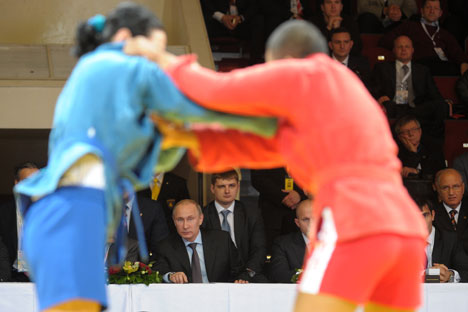
Starting in the 1950s, Sambo began to increase in popularity in the Soviet Union as a national martial art. Source: RIA Novosti
From Nov. 22-24, St. Petersburg played host to the World Sambo Championships. The competition was the culmination of an important year for Sambo. The martial art was developed in the Soviet Union in 1938, making this the 75th anniversary of its creation, and the first world championship of Sambo was held 40 years ago, in 1973 in Tehran.
The St. Petersburg tournament set new records for both the number of participating countries and the number of athletes who competed for medals. A total of 600 Sambo wrestlers from more than 75 countries took part.
Sambo, a mixture of different wrestling styles, is the most popular martial art in Russia. "Today, more than 410,000 people practice Sambo in Russia. No other country has so many people practicing it regularly,” said Vasily Shestakov, president of the International Sambo Federation.
It’s impossible to name one person the founder of Sambo. Anatoly Kharlampiev is considered to the official founder since his book, Sambo Wrestling, became the first guide for the sport. However, Viktor Spiridonov is recognized as the father of combat Sambo and Viktor Oschepkov - Sambo sports.
Spiridonov, a former staff captain of the tsarist army who survived both the Russian-Japanese War and First World War in the 1920s laid the foundation for the sport. "The art of self-defense helps to win by tooth and nail <...>, you need to use all the useful techniques from other systems, as long as they lead you to victory," he once wrote.
Spiridonov incorporated techniques from traditional fighting styles of the various Soviet ethnic groups as well as from jiu-jitsu, Greco-Roman wrestling and freestyle wrestling. He borrowed punches from English and French boxing, as well from underground fights. The grip types used in Sambo testify to their origins in various national wrestling styles, including Georgian, Ossetian, and Kazakh. The grip on the belt, which was not originally used in judo, came from Russian belt wrestling and Tatar Kurash.
Spiridonov who also worked for the NKVD (forerunner of the KGB), focused the moves of his sport on practical effectiveness for law enforcement officers. His training program was only available to NKVD members.
Unlike jiu-jitsu and judo, where it was believed that "every technique is always a success under any conditions," the founders of Sambo devised ways to transit from one failed technique into a new one.
Generally, Sambo is based not on techniques but on "principle." If, for example, judo strictly requires practitioners to have well-defined movements, then in Sambo, competitors are encouraged to use them also for other grips and poses. In judo it’s prohibited to lock legs to force submission, but in sambo it’s a whole new trend.
Starting in the 1950s, Sambo began to increase in popularity in the Soviet Union as a national martial art. International competition began in 1972. In 1981, the IOC recognized Sambo as an Olympic sport and in July 2013, Sambo competitions were held for the first time at the World Student Games in Kazan. However, Sambo still does not appear in the Olympic Games.
"We are working hard to make Sambo an Olympic sport," - said Vasily Shestakov. "The most encouraging thing is that Sambo events are visited by numerous spectators."
All rights reserved by Rossiyskaya Gazeta.
Subscribe
to our newsletter!
Get the week's best stories straight to your inbox